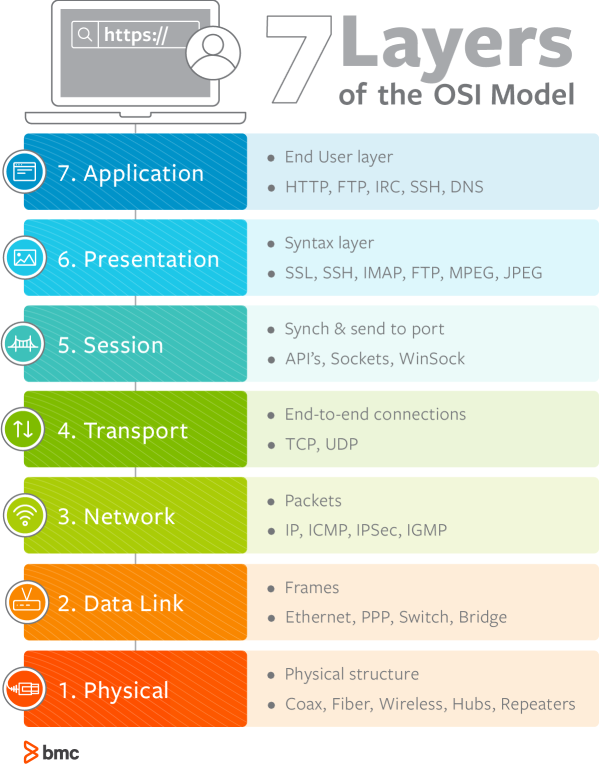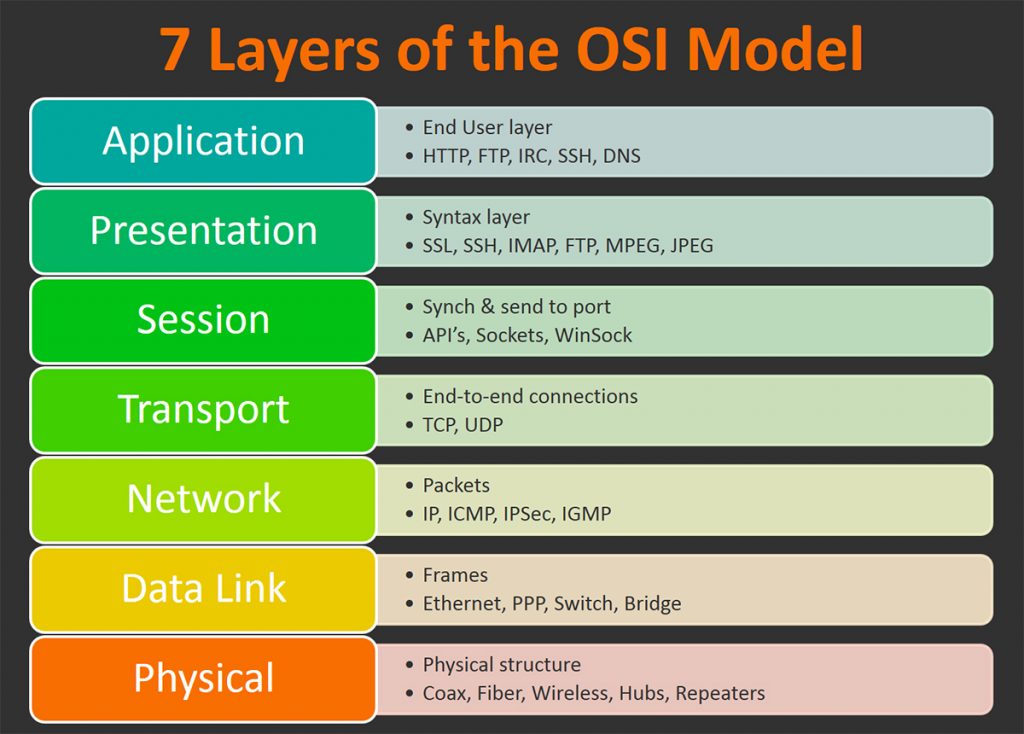The Open Systems Interconnection (OSI) Reference Model is a conceptual framework that describes functions of the networking or telecommunication system independently from the underlying technology infrastructure. It divides data communication into seven abstraction layers and standardizes protocols into appropriate groups of networking functionality to ensure interoperability within the communication system regardless of the technology type, vendor, and model.
The OSI model was originally developed to facilitate interoperability between vendors and to define clear standards for network communication. However, the older TCP/IP model remains the ubiquitous reference framework for Internet communications today.
Elevate your IT Service Management game plan with BMC Helix. ›
The 7 layers of the OSI model
This image illustrates the seven layers of the OSI model. Below, we’ll briefly describe each layer, from bottom to top.
1. Physical
The lowest layer of the OSI model is concerned with data communication in the form of electrical, optic, or electromagnetic signals physically transmitting information between networking devices and infrastructure. The physical layer is responsible for the communication of unstructured raw data streams over a physical medium. It defines a range of aspects, including:
- Electrical, mechanical, and physical systems and networking devices that include specifications such as cable size, signal frequency, voltages, etc.
- Topologies such as Bus, Star, Ring, and Mesh
- Communication modes such as Simplex, Half Duplex, and Full Duplex
- Data transmission performance, such as Bit Rate and Bit Synchronization
- Modulation, switching, and interfacing with the physical transmission medium
- Common protocols including Wi-Fi, Ethernet, and others
- Hardware including networking devices, antennas, cables, modem, and intermediate devices such as repeaters and hubs
2. Data Link
The second layer of the OSI model concerns data transmission between the nodes within a network and manages the connections between physically connected devices such as switches. The raw data received from the physical layer is synchronized and packaged into data frames that contain the necessary protocols to route information between appropriate nodes. The data link layer is further divided into two sublayers:
- The Logical Link Control (LLC) sublayer is responsible for flow controls and error controls that ensure error-free and accurate data transmission between the network nodes.
- The Media Access Control (MAC) sublayer is responsible for managing access and permissions to transmit data between the network nodes. The data is transmitted sequentially and the layer expects acknowledgement for the encapsulated raw data sent between the nodes.
3. Network
The third layer of the OSI model organizes and transmits data between multiple networks.
The network layer is responsible for routing the data via the best physical path based on a range of factors including network characteristics, best available path, traffic controls, congestion of data packets, and priority of service, among others. The network layer implements logical addressing for data packets to distinguish between the source and destination networks.
Other functions include encapsulation and fragmentation, congestion controls, and error handling. The outgoing data is divided into packets and incoming data is reassembled into information that is consumable at a higher application level. Network layer hardware includes routes, bridge routers, 3-layer switches, and protocols such as Internet (IPv4) Protocol version 4 and Internet Protocol version 6 (IPv6).
4. Transport
The fourth layer of the OSI model ensures complete and reliable delivery of data packets.
- The transport layer provides mechanisms such as error control, flow control, and congestion control to keep track of the data packets, check for errors and duplication, and resend the information that fails delivery. It involves the service-point addressing function to ensure that the packet is sent in response to a specific process (via a port address).
- Packet Segmentation and reassembly ensure that the data is divided and sequentially sent to the destination where it is rechecked for integrity and accuracy based on the receiving sequence.
Common protocols include the Transmission Control Protocol (TCP) for connection-oriented data transmission and User Datagram Protocol (UDP) for connectionless data transmission.
5. Session
As the first of three layers that deal with the software level, the session layer manages sessions between servers to coordinate communication. Session refers to any interactive data exchange between two entities within a network. Common examples include HTTPS sessions that allow Internet users to visit and browse websites for a specific time period. The Session Layer is responsible for a range of functions including opening, closing, and re-establishing session activities, authentication and authorization of communication between specific apps and servers, identifying full-duplex or half-duplex operations, and synchronizing data streams.
Common Session Layer protocols include:
- Remote procedure call protocol (RPC)
- Point-to-Point Tunneling Protocol (PPTP)
- Session Control Protocol (SCP)
- Session Description Protocol (SDP), as described here
6. Presentation
The sixth layer of the OSI model converts data formats between applications and the networks. Responsibilities of the presentation layer include:
The presentation layer, also called the syntax layer, maps the semantics and syntax of the data such that the received information is consumable for every distinct network entity. For example, the data we transfer from our encryption-based communication app is formatted and encrypted at this layer before it is sent across the network.
At the receiving end, the data is decrypted and formatted into text or media information as originally intended. The presentation layer also serializes complex information into transportable formats. The data streams are then deserialized and reassembled into original object format at the destination.
7. Application
The application layer concerns the networking processes at the application level. This layer interacts directly with end-users to provide support for email, network data sharing, file transfers, and directory services, among other distributed information services. The upper most layer of the OSI model identifies networking entities to facilitate networking requests by end-user requests, determines resource availability, synchronizes communication, and manages application-specific networking requirements. The application layer also identifies constraints at the application level such as those associated with authentication, privacy, quality of service, networking devices, and data syntax.
Common application layer protocols include:
- File Transfer Protocol (FTP)
- Simple Mail Transfer Protocol (SMTP)
- Domain Name System (DNS)
The internet doesn’t welcome OSI
The OSI model is widely criticized for an inherent implementation complexity that renders networking operations inefficient and slow. The academic approach to developing the OSI protocol suite relied on replacing existing protocols across all communication layers with better alternatives.
This approach failed to gain traction in the industry; vendors had already invested significant resources in TCP/IP products and had to manage interoperability with the vast choices of protocols and specifications offered by the OSI model. Additionally, academia itself considered the OSI model as an invention politically inspired by the European telecommunication and U.S. government authorities.
The older TCP/IP architecture model had already itself in real-world network environments. It served as a solid foundation for the Internet–including all of the security, privacy, and performance-related challenges. Continued research and development, investments, and industry-wide adoption of the OSI model could have made today’s cyber world a different (and perhaps better) place, but the pragmatism of the TCP/IP model gave us the internet that prevails today.
Additional resources
Learn more with these resources:
- BMC IT Operations Blog
- IT Infrastructure Management: An Introduction
- IT Infrastructure Planning: Getting Started
- Network Engineer vs Network Administrator: Roles, Responsibilities, and Job Descriptions
- What Is a Virtual Network?
Osi model 7 Layers from Siddique Ibrahim
Original reference image:









